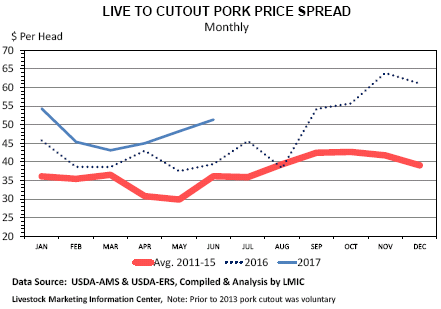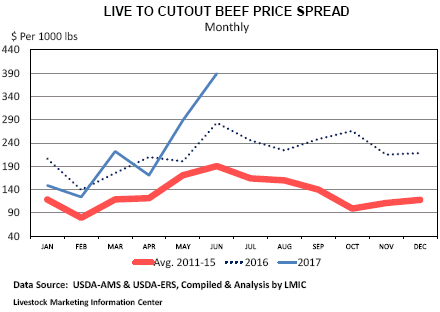



CME: Strong Demand for Meat Products Feeds Back Into Wholesale Prices
US - In yesterday’s Daily Livestock Report we stated: "With production increasing, foreign demand for pork items will likely remain a key to hog prices," writes Steiner Consulting Group, DLR Division, Inc.In our assessment, another factor to consider regarding US hog prices is how much and how quickly packer margins adjust as the new plants come on-line later this year. This newsletter, articles in industry publications (e.g. pork newsletters and magazines), and sector reports (e.g. CoBank did a report and the news release is here) have discussed the expansion in US hog slaughter capacity.
Although no dramatic increases in US beef packing capacity have been announced, the recent surge in calculated packer margins merits note. A factor influencing year-over-year and month-on-month changes in fed cattle prices for the balance of 2017 could be beef packer margins.
Packer margins are typically calculated by taking the wholesale value of a carcass (using the USDA-AMS reported cutout value) plus the value of the byproduct (non-carcass items like liver, tallow, hide/skin, etc.) minus the cost paid for a slaughter ready animal. Importantly, those calculations do not include all costs of production for a packer (labor, plant operating costs, etc.) and also do not include returns from further processing and packaging of meat and byproducts, which are increasingly done by companies that own packing plants.
When the packer margin is relatively weak, it often reflects tight available animal supplies relative to processing capacity. Seasonally, fluctuations in slaughter-ready animal supplies are apparent in the provided graphics. For hogs, the highest margins are in September-November when animal supplies are largest. Fed cattle availability tends to be largest in June, and that is when packer margins typically peak.


This year had an additional factor at work, especially for beef in the last two months. Very strong demand for meat products has fed back into strong wholesale prices, propping up packer margins. Packers have responded to large margins by aggressively purchasing animals for slaughter.
According to calculations by the Livestock Marketing Information Center (LMIC), which rely on USDA reported data, 2016 had the highest annual average calculated pork live-to-cutout price spread (packer margin) since 2014. Beginning in September of 2016, the pork margin surged and was larger than any prior quarterly calculation by the LMIC (back to 1987).
The live-to-cutout spread for beef in calendar year 2016 was the largest (not adjusted for inflation) since the LMIC began those calculations in 1980. The June 2017 beef packer margin was the largest calculated by the LMIC for any month. Note that in the second half of last year, that margin stayed rather stable month-to-month and did not decline seasonally.
Competition for animals due to additional US hog slaughter capacity later this year is expected to pressure packer margins compared to 2016’s. That margin could be compressed enough compared to a year earlier to cause slaughter hog prices to be above 2016’s, even with increased pork production. The case for tighter beef packer margins in coming months (a seasonal decline from June’s) could also be made, but the story is not as clear-cut as it is for hogs.








